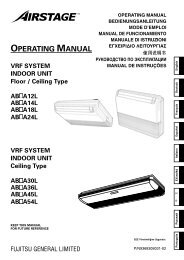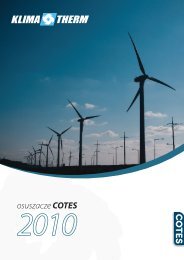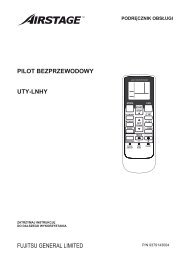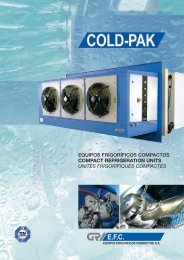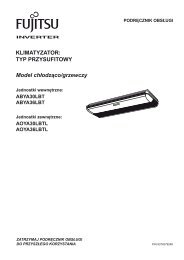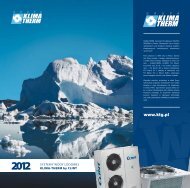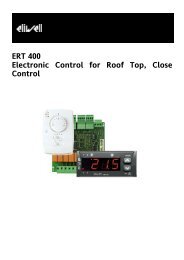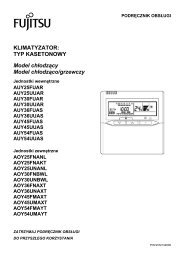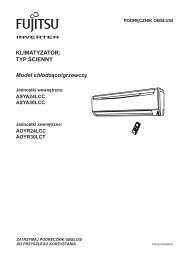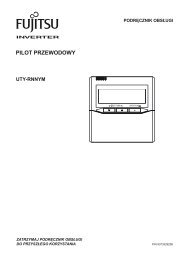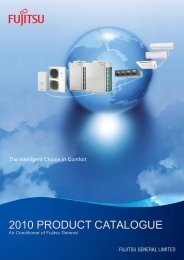CHA-CLK-K 15÷151 CLM 103.7 ab.indd - Klima-Therm
CHA-CLK-K 15÷151 CLM 103.7 ab.indd - Klima-Therm
CHA-CLK-K 15÷151 CLM 103.7 ab.indd - Klima-Therm
You also want an ePaper? Increase the reach of your titles
YUMPU automatically turns print PDFs into web optimized ePapers that Google loves.
<strong>CHA</strong>/<strong>CLK</strong> - <strong>CHA</strong>/K3.4 DISPOSITIVI DI EMERGENZAE DI SI CU REZ ZA3.4 EMERGENCY AND SAFETY DEVICESUn dispositivo di emergenza che tolga tensione dalla macchina deve essere previstoall’esterno della stessa a cura di chi installala macchina.An emergency external circuit breaker mustbe fitted by the unit installer to disconnectthe unit from the power supply.3.5 DESCRIZIONE DEL RISCHIO RESIDUO3.5 DESCRIPTION OF RESIDUE RISKSLa descrizione del rischio residuo prende in con si de r-azione i seguenti elementi:- a quale tipologia di pericoli è soggetto chi opera nell’ambi to della macchina;- la descrizione dei principali pericoli;- chi può essere esposto a tali pericoli;- quali sono le principali misure di sicurezza adottateper ridurre il rischio di infortuni.Le indicazioni per la prevenzione degli infortuni di seguitoriportate, con riferimento alle relative aree a rischiore si duo, devono essere integrate con tutte le indicazionigenerali del presente capitolo e con le norme dipre ven zio ne infortuni vigenti nel paese di de sti na zio nedell’impianto.The description of residue risks includes the followingelements:- the kind of danger the people working on the unit aresubjected to;- description of the main dangers;- who is exposed to such dangers;- the main safety methods used to reduce the risk ofinjury.The following accident prevention instructions, withref er ence to the relative areas concerned by residuerisks, must be integrated with all the general indicationscon tained in the present chapter and with theaccident prevention regulations in force in the countryof installation.3.5.1 Rischio residuo in prossimità della macchina- Folgorazione, se non vengono effettuati cor ret ta men tel’allacciamento elettrico e la messa a terra della macchina.- Tagli o escoriazioni per la presenza di superfici taglienti.- Aspirazione e successiva dispersione in ambientedelle sostanze presenti sul luogo dell’installazione.- Proiezione di eventuali oggetti che possano caderesulle pale dei ventilatori.- Fuoriuscita di acqua (in caso di anomalia).- Formazione di acqua di condensa e di ghiaccio nellazona antistante la macchina durante il funzionamentoin riscaldamento delle macchine a pompa di calore.- Alterazione del microclima (durante il fun zio na -mento).- Emissione di rumore (durante il funzionamento).- Fuoriuscita di olii (per anomalia).- Fuoriuscita del frigorigeno (per anomalia).N.B. Il frigorigeno è una sostanza ad effetto serra.Si tratta di vapori più pesanti dell’aria e chepossono provocare soffocamento riducendol’os si ge no disponibile per la respirazione. Unarapida eva po ra zio ne del liquido può causarecongelamento.3.5.1 Residue risks near the unit- Electrocution if the unit is not properly corrected tothe mains power supply and earth circuit.- Cuts or <strong>ab</strong>rasions caused by sharp surfaces.- Extraction and subsequent dispersion in the en vi -ron ment of substances present in the installationsite.- Ejection of objects falling on the fan blades.- Leaking water (in case of malfunction).- Formation of condensation and ice in front of the unitwhile the unit heat pumps are working.- Alteration of the micro climate (during operation).- Noise (during operation).- Leaking oil (in case of malfunction).- Leaking refrigerant liquid (in case of malfunction).N.B. Refrigerant liquid is a substance which causes agreenhouse effect. Its vapours are heavier thanair and can cause suffocation by reducing theamount of oxygen avail<strong>ab</strong>le for breath ing. Rapidevaporation of the liquid can cause freezing tooccur.11



